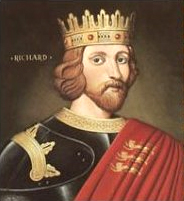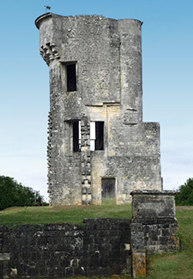King Richard 1st (Lionheart)
 King Richard I is always considered a great military leader and warrior king often referred to as Lionheart for his acts of chivalry particularly on the third Crusade but in fact Richard spent almost all of his reign abroad (at least nine out of 10 years) and appeared to view England as a source of funding for the defence of his French territories as well as for his crusade. By the time he died, as well as being king of England, he had also ruled as Duke of Normandy, Duke of Aquitaine, Duke of Gascony, Lord of Ireland, Lord of Cyprus, Count of Anjou, Count of Maine, Count of Nantes, and Overlord of Brittany at various times during his reign. Right: 17th-century portrait of Richard
King Richard I is always considered a great military leader and warrior king often referred to as Lionheart for his acts of chivalry particularly on the third Crusade but in fact Richard spent almost all of his reign abroad (at least nine out of 10 years) and appeared to view England as a source of funding for the defence of his French territories as well as for his crusade. By the time he died, as well as being king of England, he had also ruled as Duke of Normandy, Duke of Aquitaine, Duke of Gascony, Lord of Ireland, Lord of Cyprus, Count of Anjou, Count of Maine, Count of Nantes, and Overlord of Brittany at various times during his reign. Right: 17th-century portrait of Richard
 Richard the Lionheart was born in 8 September 1157 in Oxford but was raised at Poitiers in France - the second and favourite son of his mother Eleanor of Aquitaine.
Not much is known regarding Richard's education but it is generally agreed that Richard could speak no English. He was an educated man who liked to compose poetry and wrote both in Limousin (lenga d'òc) and also in French. He was said to be very tall and handsome with a hair colour something between red and blond. He had blue eyes and a pale complexion. Most scholars believe that he was above average height although his exact height is unknown. Left: Richard I. Cœur de Lion (Lionheart) Illustration from a 12th century codex
Richard the Lionheart was born in 8 September 1157 in Oxford but was raised at Poitiers in France - the second and favourite son of his mother Eleanor of Aquitaine.
Not much is known regarding Richard's education but it is generally agreed that Richard could speak no English. He was an educated man who liked to compose poetry and wrote both in Limousin (lenga d'òc) and also in French. He was said to be very tall and handsome with a hair colour something between red and blond. He had blue eyes and a pale complexion. Most scholars believe that he was above average height although his exact height is unknown. Left: Richard I. Cœur de Lion (Lionheart) Illustration from a 12th century codex
 By the age of 15, Richard had already inherited his mother's realm of Aquitaine and with the death of his elder brother Henry the Young King in 1183, he became heir to the English throne as well as benefiting from inheriting the latter's titles and lands. Despite all this good fortune, Richard would not pass on Aquitaine to his brother John as his father wanted him to do and this began a family feud which would continue on and off for years. Encouraged by his mother Eleanor, Richard took part in a revolt against his father King Henry II in 1173. In 1179 at the age of 22, he proved himself in battle being instrumental in the capture of Taillebourg castle (Photo Right) during a campaign in Aquitaine to subdue rebel lords.
By the age of 15, Richard had already inherited his mother's realm of Aquitaine and with the death of his elder brother Henry the Young King in 1183, he became heir to the English throne as well as benefiting from inheriting the latter's titles and lands. Despite all this good fortune, Richard would not pass on Aquitaine to his brother John as his father wanted him to do and this began a family feud which would continue on and off for years. Encouraged by his mother Eleanor, Richard took part in a revolt against his father King Henry II in 1173. In 1179 at the age of 22, he proved himself in battle being instrumental in the capture of Taillebourg castle (Photo Right) during a campaign in Aquitaine to subdue rebel lords.
Possibly because he had heard the stories of his fearless mothers travels to the Holy Land alongside her first husband Louis VII of France that Richard had grown up with a passionate desire to prove himself a brave chivalric Prince who would go on crusades and achieve great things in the Holy Land. So it was that when Richard came to the throne in the summer of 1189, his first thoughts were fixed on how to raise money for a new third crusade to the Holy Land - the main aim being to recapture Jerusalem from the Saracens. Richard had 'taken the Cross' (the symbol of the Knights Templar) two years before he had acceded to the throne and was now eager to fight the Muslim infidels as he viewed them. In order to raise the money, in December 1189, Richard cancelled the treaty of Falaise through which the Scots recognised his feudal superiority over Scotland in return for money -- a payment from King William of Scots of 10,000 marks. With the necessary funds in place, Richard along with his ally Philip II of France set off the following summer of 1190 to do battle with the Kurdish warrior Saladin. - King Richard I Part 2


